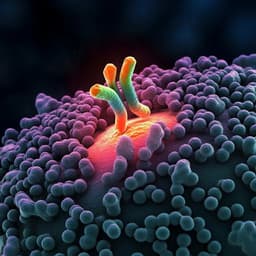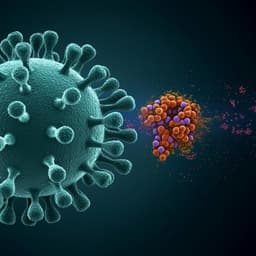
Medicine and Health
Potent neutralization of SARS-CoV-2 variants by RBD nanoparticle and prefusion-stabilized spike immunogens
M. C. Miranda, E. Kepl, et al.
This groundbreaking study explores how RBD-NP immunogens, refined with mutations from SARS-CoV-2 variants like B.1.351 and P.1, can adapt to Omicron strains. The authors reveal that these innovative vaccines can elicit strong neutralizing antibody responses against variants, demonstrating rapid design and stability, making them promising candidates for a broadly protective coronavirus vaccine platform.
~3 min • Beginner • English
Introduction
SARS-CoV-2 caused a global public health crisis since late 2019. Vaccines based on the ancestral (Wu-1) spike effectively reduced severe disease and death. However, mutations in spike of emerging variants reduced neutralization potency of sera from infected or immunized individuals against variants of concern (VOCs), such as B.1.351 (β) and later Omicron lineage variants. There is limited information on how non-mRNA vaccine platforms tolerate antigen updates, which is important for updating vaccines and for pandemic preparedness. The authors previously developed a computationally designed receptor binding domain protein nanoparticle vaccine (RBD-NP) that protected animals, met Phase III endpoints, and was licensed in South Korea and the UK (SKYCovione). While mosaic RBD-NPs are being explored for broad sarbecovirus protection, open questions remain about update frequency and platform amenability to strain updates. This study describes variant-updated RBD-NP vaccines based on Wu-1, β, and γ lineages benchmarked against prefusion-stabilized (HexaPro) spikes, investigates stability and antigenicity differences, and assesses whether stabilizing mutations can improve manufacturability and immunogenicity, thereby informing variant vaccine development.
Literature Review
Methodology
Design and constructs: Two-component self-assembling protein nanoparticles (153-50 platform) presenting 60 RBDs per particle were used. RBDs from Wu-1, B.1.351 (β), P.1 (γ) (mutations K417N/T, E484K, N501Y), and a single-point E484K mutant were genetically fused to the trimeric 153-50A component with a 16-residue GS linker. Stabilizing mutations (“Rpk9”: Y365F, F392W, V395I) targeting the RBD linoleic acid binding pocket were introduced into variant RBDs. Prefusion-stabilized spike ectodomains (HexaPro; 6 proline substitutions and modified furin site) for Wu-1, β, and γ were also produced.
Expression and purification: Antigen-bearing 153-50A trimers and HexaPro spikes were expressed in Expi293F cells and purified by immobilized metal affinity chromatography. The 153-50B.4PT1 pentameric component was expressed in E. coli and purified via inclusion body extraction and ion exchange. VOC-RBD-153-50A fusions were dialyzed into an excipient-rich buffer (MAGIC Sauce: Tris, NaCl, L-arginine, glycerol, CHAPS). HexaPros were dialyzed into Tris/NaCl/histidine/glycerol buffer. Endotoxin levels were quantified (threshold <50 EU/mg).
Nanoparticle assembly and characterization: Nanoparticles were assembled in vitro at 1.1:1 molar ratio of RBD-153-50A trimer to 153-50B.4PT1 pentamer, purified by SEC (Superose 6 Increase), and analyzed by dynamic light scattering (DLS) and negative stain EM (nsEM). Size-exclusion chromatography (SEC) in different buffers assessed solution properties. NanoDSF measured melting temperatures (Tm) for components and aggregation onset (Tagg) for NPs.
Antigenicity assays: Biolayer interferometry (BLI) assessed binding of immobilized trimeric RBD-153-50A components to monomeric hACE2 and to Fabs from LY-CoV555 and CR3022. ELISA probed antigenicity of HexaPro spikes including NTD-directed mAb S2L28 binding.
Stability studies: Shelf-life stability of monovalent RBD-NPs and NP cocktails was assessed over 28 days at four temperatures (<−70, 2–8, 22–27, and 35–40 °C) using SDS-PAGE, nsEM, DLS, UV/vis absorbance (A320/280), and BLI for hACE2 binding.
HDX-MS: Hydrogen/deuterium exchange mass spectrometry on selected RBD peptides compared WT and Rpk9 variants (β and γ) to assess local stabilization, particularly around the linoleic acid binding site.
Animal immunizations: BALB/c mice (n=5/group) received two doses (weeks 0 and 3) of 1 µg RBD-NPs (monovalent, mosaics co-displaying Wu-1/β or Wu-1/β/γ, or cocktails mixing monovalent NPs) adjuvanted with AddaVax; or 5 µg HexaPro spikes (Wu-1, β, γ) and cocktails, adjuvanted with AddaVax. Separate Darwin mice (human Ig locus transgenic; n=5/group) received prime-boost with AddaVax and a final IV boost without adjuvant.
Pseudovirus neutralization: Sera were tested two weeks post-boost (BALB/c) or 0.5 weeks post-IV boost (Darwin) against VSV pseudoviruses bearing SARS-CoV-2 S of G614 (Wu-1), β, γ, B.1.617.2 (δ), and B.1.1.529 BA.1 (Omicron). IC50 titers were determined via luciferase readout. Geometric mean titers (GMTs) were calculated. Kruskal–Wallis tests assessed group differences.
Additional experimental details: UV/vis quantification, DLS parameters, nsEM preparation, hACE2-Fc/antibody Fab preparation, BLI kinetics, ELISA procedures, HDX-MS acquisition and analysis, nanoDSF settings, cell culture conditions, and pseudovirus production and infection conditions are provided in Methods.
Key Findings
- Particle integrity and antigenicity:
- All eight monovalent RBD-NPs (Wu-1, β, γ, E484K, each ±Rpk9) showed expected size and morphology by DLS and nsEM. HexaPro spikes for Wu-1, β, γ were properly folded by nsEM.
- Antigenicity by BLI/ELISA: hACE2 binding affinities were similar between WT and Rpk9 variant-matched components. E484K substitution abrogated LY-CoV555 binding as expected. Rpk9 mutations caused minimal, consistent reduction in CR3022 binding (<2-fold). VOC HexaPros lost S2L28 (NTD) binding; RBD and hACE2 binding profiles were preserved.
- Biophysical stability:
- Rpk9 increased RBD component Tm by ~5–6 °C across Wu-1 and VOC RBDs (e.g., Wu-1-RBD-153-50A from ~37 °C to ~43 °C under current buffer conditions).
- HDX-MS showed reduced exchange (stabilization) near residues 351–365 and 392–399 (linoleic pocket) with Rpk9, with no change at key neutralizing epitope regions (400–431, 453–471, 472–487).
- Despite component stabilization, β- and γ-RBD-NPs had poorer solution properties than Wu-1-RBD-NP, even in excipient-rich buffers. Aggregation onset temperatures for Rpk9-NPs were slightly lower than WT in current buffer conditions.
- Expression/assembly observations: BA.4/5 RBD-NPs required Rpk9 for expression/assembly; without Rpk9, expression was undetectable. XBB.1.5 RBD-NPs expressed at high yield and behaved well in solution.
- Shelf-life (28-day) stability:
- Wu-1-RBD-NP remained stable at <−70, 2–8, and 22–27 °C; at 35–40 °C showed some aggregation by day 28 and reduced hACE2 binding starting day 7.
- β-RBD-NP was least stable: degradation at 22–27 and 35–40 °C (SDS-PAGE), aggregation from 2–8 to 35–40 °C, and progressive loss of hACE2 binding with temperature. γ-RBD-NP showed similar but less pronounced trends.
- Rpk9 introduction markedly improved hydrodynamic stability of β- and γ-RBD-NPs, though antigenicity still declined over time at 35–40 °C.
- NP cocktails with Wu-1 (e.g., cWu-1β-RBD-NP) improved aggregation and antigenicity compared to β alone; Rpk9 further improved stability in cocktails.
- Immunogenicity in BALB/c mice (pseudovirus neutralization):
- All immunogens elicited neutralizing antibodies against G614 (Wu-1), β, γ, δ, and BA.1 two weeks post-boost, though some mice lacked detectable BA.1 neutralization. Bare 153-50 scaffold induced no neutralization.
- Wu-1-RBD-NP elicited high nAb titers across VOCs, with GMTs ranging from 1×10^1 to 1.2×10^6, except BA.1 (GMT 94.5).
- Rpk9 improved vaccine-mismatched neutralization in several cases without reducing matched titers:
- β-RBD-NP+Rpk9 increased neutralization vs Wu-1, γ, δ, BA.1 by ~3.9×, 1.4×, 1.8×, and 3.4×, respectively.
- γ-RBD-NP+Rpk9 increased neutralization vs Wu-1, β, γ, δ by ~4.3×, 1.6×, 4.3×, and 4.1×; BA.1 largely unchanged.
- E484K-RBD-NP induced BA.1 nAb titers 14–18× higher than corresponding Wu-1 RBD-NPs.
- Mosaics and cocktails of RBD-NPs (with or without Rpk9) elicited nAb titers comparable to monovalents across matched and mismatched VOCs; Rpk9 mainly boosted BA.1 responses in multivalent formats (e.g., 2.4×, 31×, 3.9× increases in mosaic bivalent, cocktail bivalent, mosaic trivalent groups, respectively).
- Immunogenicity with HexaPro spikes:
- Monovalent Wu-1-, β-, and γ-HexaPros elicited strong matched neutralization; Wu-1-HexaPro showed larger drops in mismatched neutralization (except δ) compared to β- and γ-HexaPro.
- Cocktails of HexaPros (Wu-1/β and Wu-1/β/γ) elicited high nAb levels across all variants tested, including δ and BA.1, outperforming Wu-1-only formulations for heterologous neutralization.
- Immunogenicity in Darwin (human Ig locus) mice:
- Wu-1-RBD-NP induced significantly higher and comparable G614 neutralization than VOC-Rpk9-RBD-NPs and NP cocktails, respectively.
- Against β and γ, Wu-1-RBD-NP, VOC-Rpk9-RBD-NPs, and cocktails elicited equivalent nAb titers.
- Wu-1-RBD-NP yielded the highest nAb titers against δ and BA.1 in Darwin mice, suggesting robust breadth in a humanized repertoire.
Overall: RBD-NP and HexaPro platforms—especially when incorporating multiple VOC antigens or stabilizing mutations—elicited potent neutralizing antibodies against diverse SARS-CoV-2 variants. However, immunogen properties varied by variant, impacting manufacturability and stability.
Discussion
The study addressed whether RBD nanoparticle immunogens and prefusion-stabilized spike trimers can be updated to variant sequences while maintaining stability, antigenicity, and breadth of neutralizing responses. Findings show that while antigenicity of key epitopes is generally preserved and neutralizing responses are robust across variants, the physical properties and manufacturability of protein immunogens vary substantially among variants. Rpk9 linoleic-pocket stabilizing mutations consistently increased RBD thermal stability and improved solution properties for problematic VOC RBDs (β, γ), leading to better shelf-life metrics and, in several cases, enhanced vaccine-mismatched neutralization without compromising matched titers. Nonetheless, Rpk9 did not universally correct poor solution behavior or prevent antigenicity loss at elevated temperatures. Importantly, Wu-1-RBD-NP performed strongly across VOCs in both BALB/c and humanized Darwin mice, with particularly broad responses in the latter, indicating that inclusion of only the RBD can match or rival performance of full-length spike immunogens for eliciting neutralization breadth. Multivalent formulations (mosaic or cocktail) of RBD-NPs and HexaPro spikes improved heterologous neutralization, especially against divergent variants like BA.1 and δ, supporting multivalent antigen inclusion for breadth. The study underscores the need to balance antigen update benefits with potential liabilities in protein stability and expression for each new variant. It also highlights complementary strategies—such as mosaic nanoparticle displays and mRNA-launched nanoparticle immunogens—to achieve both breadth and rapid deployability for antigenically evolving pathogens.
Conclusion
This work demonstrates that two-component RBD nanoparticles and prefusion-stabilized spike trimers can be rapidly adapted to SARS-CoV-2 variants and elicit potent neutralizing antibody responses across diverse VOCs. Rpk9 stabilizing mutations increase RBD thermal stability and often improve solution behavior and heterologous neutralization, enabling production of certain variant RBD-NPs (e.g., BA.4/5) that otherwise fail to express. However, variant-to-variant variability in expression, aggregation propensity, and shelf-life suggests that protein-based vaccine updates may require additional, portable stabilizing designs to ensure manufacturability and stability. Monovalent Wu-1-RBD-NP provided strong, consistent cross-variant neutralization, particularly in humanized mice, while multivalent RBD-NP and HexaPro cocktails enhanced breadth against antigenically divergent strains. Future directions include: identifying additional broadly portable stabilizing mutations across sarbecovirus RBDs; advancing mosaic/multivalent RBD-NP vaccines for broad protection; exploring mRNA-launched nanoparticle platforms to combine protein NP potency with rapid manufacturing; and continued monitoring of variant-specific biophysical behavior to inform timely and feasible vaccine updates.
Limitations
- Variant-dependent manufacturability: β- and γ-RBD-NPs showed low expression yields and aggregation, and BA.4/5 RBD-NPs required Rpk9 for detectable expression; Rpk9 did not universally resolve stability issues.
- Stability at elevated temperature: Even with Rpk9, antigenicity declined over time at 35–40 °C; β-RBD-NP was notably unstable.
- Model systems: Immunogenicity was assessed in BALB/c and Darwin mice; responses may not fully generalize to humans, and differences between mouse models (e.g., immunodominance at RBD position 484) affect breadth.
- Preclinical focus: No human immunogenicity data for the newly designed variant constructs in this study (though platform has clinical precedent). Challenge studies were not included here.
- Buffer/context sensitivity: Some disparities with prior stability results were attributed to different buffer formulations (e.g., CHAPS presence), indicating context-dependent behavior.
- Limited scope of variants in in-depth biophysics: Detailed stability and HDX-MS centered on Wu-1, β, and γ; emerging Omicron sublineages were only partially evaluated (e.g., BA.4/5, XBB.1.5 production behavior).
Related Publications
Explore these studies to deepen your understanding of the subject.







